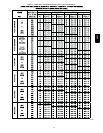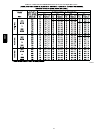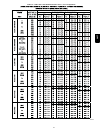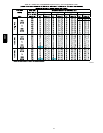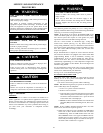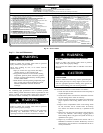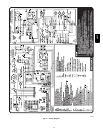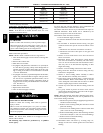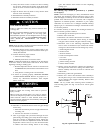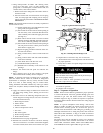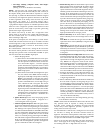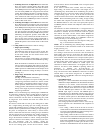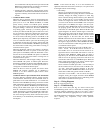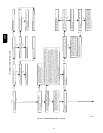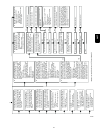
51
1. Two-- Stage Heating (Adaptive mode) with Single--
Stage Thermostat
(See Fig. 23 or 32 for thermostat connections)
NOTE: The low--heat only switch (LHT) selects either the
low--heat only operation mode when ON, (see item 2. below) or
the adaptive heating mode when OFF in response to a call for
heat. (See Fig. 33.) When the W2 thermostat terminal is energized
it will always cause high--heat operation when the R to W circuit
is closed, regardless of the setting of the low--heat only switch.
This furnace can operate as a two--stage furnace with a
single--stage thermostat because the furnace control CPU includes
a programmed adaptive sequence of controlled operation, which
selects low--heat or high--heat operation. This selection is based
upon the stored history of the length of previous gas--heating
periods of the single--stage thermostat.
The furnace will start up in either low-- or high--heat. If the
furnace starts up in low--heat, the control CPU determines the
low--heat on--time (from 0 to 16 minutes) which is permitted
before switching to high--heat.
If the power is interrupted, the stored history is erased and the
control CPU will select low--heat for up to 16 minutes and then
switch to high--heat, as long as the thermostat continues to call for
heat. Subsequent selection is based on stored history of the
thermostat cycle times.
The wall thermostat “calls for heat”, closing the R to W circuit.
The furnace control performs a self--check, verifies the low--heat
and high--heat pressure switch contacts LPS and HPS are open,
and starts the inducer motor IDM in high--speed.
a. Inducer Prepurge Period
(1.) If the furnace control CPU selects low--heat opera-
tion the inducer motor IDM comes up to speed, the
low--heat pressure switch LPS closes, and the fur-
nace control CPU begins a 15--second prepurge
period.Afterthelow--heatpressureswitchre--closes
thefurnacecontrolCPUwillbegina15--secondpre-
purge period, and continue to run theinducer motor
IDM at high--speed.
(2.) If the furnace control CPU selects high--heat opera-
tion, the inducer motor IDM remains running at
high--speed, and the high--heatpressure switch relay
HPSR is de--energized to close the NC contact.
When sufficient pressure is available the high--heat
pressure switch HPS closes, and the high--heat gas
valve solenoid GV--HI is energized. The furnace
control CPU begins a 15--second prepurge period
after the low--heat pressure switch LPS closes. If the
high--heatpressureswitch HPS fails toclose andthe
low--heat pressure switch LPS closes, the furnace
will operate atlow--heat gas flow rate until the high--
heat pressure switch closes for a maximum of 2
minutes after ignition.
b. Igniter Warm--Up--At the end of the prepurge period,
the (Hot Surface Igniter) HSI is energized for a
17--second igniter warm--up period.
c. Trial--for--Ignition Sequence--When the igniter warm--
up period is completed the main gas valve relay contacts
GVR--1 and --2 close to energize the gas valve solenoid
GV--M,thegasvalveopens,and24 vacpowerissupplied
for a field--installed humidifier at the HUM terminal. The
gasvalvesolenoidGV--M permitsgasflowto theburners
where it is ignited by the HSI. Five sec after the GVR
closes, a 2--sec flame proving period begins. The HSI ig-
niter will remain energized until the flame issensed orun-
til the 2--sec flame proving period begins. If the furnace
control CPU selects high--heat operation, the high--heat
gas valve solenoid GV--HI is also energized.
d. Flame--Proving--When the burner flame is proved at the
flame--proving sensor electrode FSE, the inducer motor
IDM switches to low--speed unless running at high--
speed, and the furnace control CPU begins the blower--
ON delay periodand continuestohold thegasvalveGV--
M open. If the burner flame is not proved within two
seconds,thecontrolCPU willclosethegasvalveGV--M,
and the control CPU will repeat the ignition sequence for
up to three more Trials--For--Ignition before going to Ig-
nition-- Lockout. Lockout will be reset automatically
after three hours, by momentarily interrupting 115 vac
power to the furnace, or by interrupting 24 vac power at
SEC1 orSEC2 to thefurnacecontrol CPU(not atW/W1,
G, R, etc.). If flame is proved when flame should not be
present, the furnace control CPU will lock out of Gas--
Heating mode and operate the inducer motor IDM on
high speed until flame is no longer proved.
e. Blower--ON Delay--If the burner flame is proven the
blower--ON delay for low--heat and high--heat are as fol-
lows:
Low-- Heat--45 seconds after the gas valve GV--M is en-
ergized the blower motor (BLWM) is energized at LO
HEAT speed.
High--Heat--25 seconds after thegas valve GV--M isen-
ergized the BLWM is energized at HI HEAT speed. Sim-
ultaneously, the electronic air cleaner (EAC--1) terminal
is energized and remains energized as long as the BLWM
is energized.
f. SwitchingfromLow--toHigh-- Heat--Ifthefurnacecon-
trol CPU switches from low--heat to high--heat, the fur-
nace control CPU will switch the inducer motor IDM
speed from low to high. The high--heat pressure switch
relay HPSR is de--energized to close the NC contact.
When sufficient pressure is available the high--heat pres-
sure switch HPS closes, and the high--heat gas valve
solenoid GV--HI is energized.The blowermotor BLWM
will switch to HI HEAT speed five seconds after the fur-
nace control CPU switches from low--heat to high--heat.
g. Switching from High-- to Low--Heat--The furnace con-
trol CPU will not switch from high--heat to low--heat
whilethethermostat R--to--W circuit isclosed when using
a single stage thermostat.
h. Blower--OFF Delay--When the thermostat is satisfied,the
R to W circuit is opened, de--energizing the gas valve
GV--M,stoppinggasflowto theburners,andde--energiz-
ing the humidifier terminal HUM. The inducer motor
IDM will remain energized for a 5--second post--purge
period. The blower motorBLWM and air cleanertermin-
al EAC--1 will remain energized for 90, 120,150, or 180
seconds (depending on selection at blower--OFF delay
switches). The furnace control CPU is factory--set for a
120--second blower--OFF delay.
2. Two--Stage Thermostat and Two--Stage Heating (See Fig.
31 for thermostat connections)
NOTE: In this mode the LHT must be ON to select the low--heat
only operation mode in response to closing the thermostat
R--to--W1 circuit. Closing the thermostat R--to--W1--and--W2
circuits always causes high--heat operation, regardless of the
setting of the low--heat--only switch.
The wall thermostat “calls for heat”, closing the R--to--W1 circuit
for low--heat or closing the R--to--W1 and--W2 circuits for
high--heat. The furnace control performs a self--check, verifies the
low--heat and high--heat pressure switch contacts LPS and HPS
are open, and starts the inducer motor IDM in high--speed.
The start up and shut down functions and delays described in
item 1. above apply to the 2--stage heating mode as well, except
for switching from low-- to high--Heat and vice versa.
58CT



